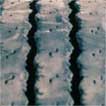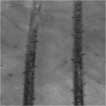Tire Wear & Replacement
Tire & Wheel Balance
Out-of-balance tires may tend to "cup" and wear excessively at the tire/wheel assembly's heaviest spot.
The weight of the tire-and-wheel assembly must be distributed uniformly around the tire's circumference.
A heavy spot in the assembly should be counter-balanced by wheel weights. Otherwise, out-of-balanced tires
tend to "cup" and wear excessively at the heavy spot. Most modern tire service locations use off-the-vehicle
computer balancers which correct for both static (single plane) and dynamic (two plane) imbalance.
Radial tires should always be dynamically balanced.
Balance
- All wheel positions
- When new tires are mounted
- When tire and wheel are moved to another wheel position
- When used tires are installed on existing wheels
- After a flat repair or any time a tire is dismounted and mounted
Vehicle Alignment
Proper wheel alignment is essential to even treadwear. The normal wear of moving parts in a suspension system
results in misalignment. When this happens, tires don’t run as straight and free as they should. The result is
tire scuffing and rapid, uneven wear. Have your vehicle’s alignment checked regularly and adjusted to the vehicle
manufacturer’s specifications.
- Incorrect alignment can cause tire scuffing and rapid, uneven wear.
- Alignments should be done by trained technicians to RV manufacturer’s specifications.
- Proper alignment can have a positive impact on fuel economy and vehicle safety.
Alignment and Wear Characteristics

Excessive Toe
- Excessive toe-in/positive toe results in outside edge wear of the tire
- Excessive toe-out/negative toe results in inside edge wear of the tire
- Toe is easily adjusted on most vehicle steer axles

Excessive Camber
- Excessive positive camber: smooth wear patterns on the outer half of the tire tread
- Excessive negative camber: smooth wear patterns on the inner half of the tire tread

Excessive Scrub
- Excessive scrub results in inside/outside steer axle tire wear patterns
- Affects all tires on the vehicle
Tire Matching Guidelines
For best performance the same tires should be used across an axle:
- All radial ply or all bias ply
- All the same size
- All the same tire tread pattern
- Approximately the same stage of wear
Dual Matching
- Dual tires should be within the following tolerances for tire circumference
- — 8.25R20 and smaller sizes - tire circumferences should be within (0 to 3/4") tolerance
- — 9.00R20 and larger sizes - tire circumferences should be within (0 to 1 1/2") tolerance
- Mismatching can result in rapid, uneven tread wear because the larger tire carries more load
�Balance
- All wheel positions
- Out of balance tires may tend to “cup” and wear excessively at the tire/wheel assembly’s heaviest spot
- Dynamic balancing should be done
- — When new tires are mounted
- — When tire and wheel are moved to another wheel position
- — When used tires are installed on existing wheels
- — After a flat repair or any time a tire is dismounted and mounted